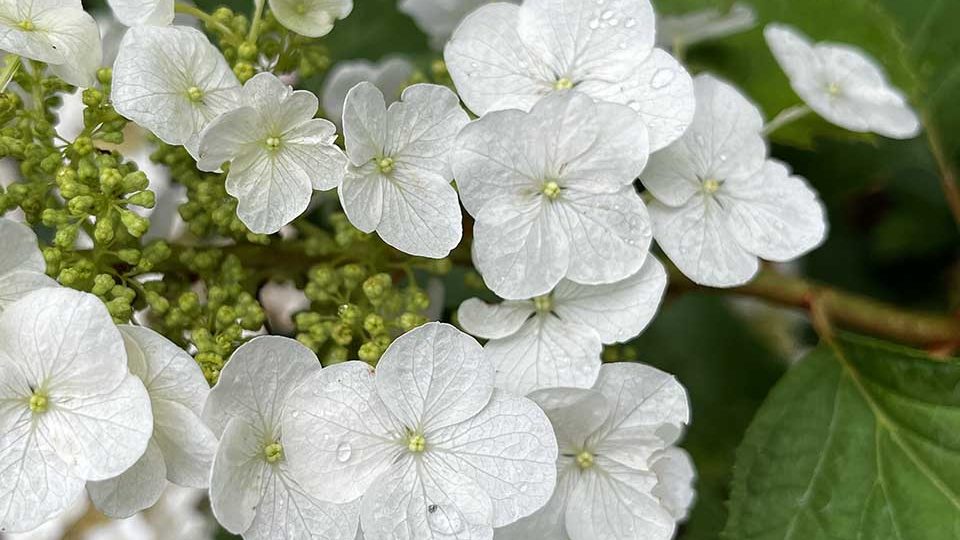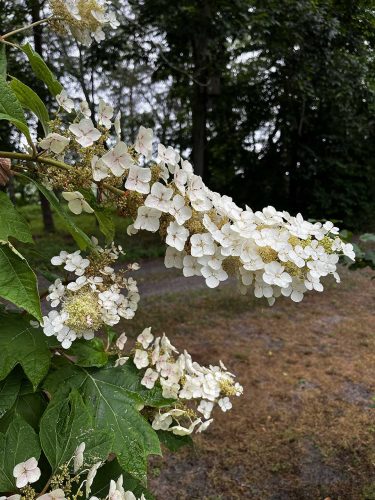Hosting a Southern Beauty
Climate change is making some southern species better suited to the Mid-Atlantic region.

 Planting native plants has become increasingly popular as people learn more about the connections between plants and animals. Life has its beginnings with water, sunlight, plants, and insects. In previous articles we have talked about the predicament we would be in if it were not for insects and the role they play in making soil, composting everything, pollinating our food, recycling the departed, and a great deal more.
Planting native plants has become increasingly popular as people learn more about the connections between plants and animals. Life has its beginnings with water, sunlight, plants, and insects. In previous articles we have talked about the predicament we would be in if it were not for insects and the role they play in making soil, composting everything, pollinating our food, recycling the departed, and a great deal more.
Most of our insects have coevolved with specific plants; native plants coupled with native insects is a codependence or mutuality that began eons ago. Because of this, European or Asian plants that are typically sold in big-box garden centers are unable to support our native insects. Furthermore, many exotic invasive plants are taking over the landscape—for example, English ivy, kudzu, mile-a-minute, phragmites, Japanese honeysuckle, water hyacinth, Japanese barberry, Norway maple, and purple loosestrife. You may as well put plastic plants in your yard; they will require less care, no harmful fertilizers, no watering, and last a lifetime—or maybe three lifetimes!
Stop! I shouldn’t be giving you advice you might take to heart. Here’s the intended take-away: Plant native plants to restore natural food webs. They provide better habitat for feeding and breeding of local animals and will give you a lifetime of wildlife-watching pleasure, as birds, butterflies, dragonflies, bees, and other insects are attracted to your yard.
It really is incumbent on those of us who are property owners to plant more native species of flora. I don’t want to burst anyone’s bubble, but much of what we buy that is called a “native” plant is not necessarily native to our region, but rather to a much broader area, like North America. These plants are often called “near native” by those in the know. Near natives aren’t necessarily a bad choice, but choosing true natives is a bigger step in the right direction.

That being said, I’m a sucker for some of the plants that are not necessarily from our region but do very well here, especially as our climate gets warmer. These include Magnolia grandiflora (southern magnolia), loblolly pine, and oakleaf hydrangea.
Global warming is driving species toward the poles worldwide and sometimes to higher elevations, to escape the heat. Not only animals and plants but also people are being displaced; unnatural migrations are afoot. In this movement species become separated from their reliance on other critters; this ecological disruption is called “delinking.” It is easier for an insect or bird to take flight than for forest trees to repopulate an area. Yet relocating without finding habitat or foraging essentials can be a recipe for disaster or, worse, extinction.
Therefore, preparing for a warming world means that planting some species that have typically grown south of us may have merit. The University of Maryland’s Extension summarizes how this might affect our current and future garden choices: “Due to our changing climate, species native to our south have the potential to be more aligned with mid-Atlantic ecosystems in the future. Gardening with projected climate impacts in mind helps to create a resilient plant community as the plant palette appropriate to our area changes. As such, some ‘near native’ plant species are included in our recommendations for adaptability.” The Maryland Climate Summary anticipates an increase in Mid-Atlantic temperatures by 2100 of 5° to 11° higher than in the 2020s.
Higher temperatures will mean more watering of stressed plants. Higher carbon dioxide levels will actually promote the growth of invasive species. More invasives means less space for natives. Warmer temperatures cause earlier leaf out and bloom times, which puts animals’ life cycles out of sync with native plants—especially pollinators. None of this can be classified as good news.
Despite the warming trends, you should certainly continue to seek out native species that will be compatible with our current suite of wildlife. However it may be time to consider including some southern species that adapt well to our current conditions and may flourish as the world grows warmer.
As previously mentioned, one such species that is native to the southeastern United States is oakleaf hydrangea or Hydrangea quercifolia, a showy deciduous shrub found on bluffs, moist woods, ravines, and stream banks from Georgia south to Florida and westward to Louisiana. It produces pyramidal panicles of whitish-green flowers that change to a purplish pink. In our area it blooms primarily in June and July. The three- to seven-lobed leaf has an oak-like appearance, hence its common name. In the fall the foliage is maroon to burgundy red, giving a nice accent to the garden. In fact the U.S. Forest Service suggests native alternatives to exotic plants and specifically calls out the autumn color of oakleaf hydrangea as an alternative to the problem plant, burning bush euonymus.

A dissection of its scientific name gives insight into its character. Hydrangea comes from Greek hydro, meaning “water,” and aggeion, meaning “vessel,” referring to the cup-like fruit. Quercus is the oak family genus but in this case it refers to the leaves, not the species itself.
Pollinators, especially bees, visit the blossoms, and birds likely eat the seeds as well as using the shrub for cover. Nature Hills Nursery lists these species of birds as likely beneficiaries—cardinals, grosbeaks, wrens, sparrows, thrushes, orioles, finches, mockingbirds, thrashers, vireos and wood-warblers.
As far as traditional uses there are records of native smooth leaf hydrangea/ Hydrangea arborescens being collected by local tribes such as the Delaware for kidney ailments and gallstones. The Cherokee used it for many medicinal purposes; bark was considered helpful for gastrointestinal issues, cancer, ulcers, and burns. The curative uses were far broader than mentioned here. Peeled branches were also prized for tea, and young twigs were peeled, boiled thoroughly, fried, and eaten. However, I found no records specific to oakleaf hydrangea.
The shrub is described as being generally six to eight feet tall and similar in width. I’ve seen it considerably taller, reaching 12 feet. It can handle heavy pruning, but nevertheless height is an important factor when deciding placement. As far as pruning hydrangeas we’ll give a shout out to Overdevest Nursery’s David Wilson who does a YouTube session on “How To Prune Hydrangeas in Early Spring;” his northern Ireland brogue alone is worth the listen.
However, the Galetto household pruning technique is much swifter than the Overdevest method. In addition, we often let the main trunk of a dead tree stand to provide habitat for wildlife. If it begins to look precarious we might address it further or remove it entirely. We live in a neighborhood where people’s yards are primarily wooded and spaced out, so this doesn’t look especially out of place.
In our yard one spring I noticed that a dead pine’s rotting trunk was leaning toward one of my favorite hydrangeas. So in my infinite wisdom I recruited my husband—chainsaw in hand—to cut it down, in a controlled fashion so as not to damage the hydrangea. Mind you, this pine was about 20 inches or more in diameter. He dutifully scoped out the angles and proceeded to cut. There was no waver in the fall, nor that pregnant pause you associate with a felled tree. No suspense. No sirree, this tree with great deliberate force bisected our lovely hydrangea. It crushed it squarely in its center, as if it had a vendetta, as if it had grown with the sole purpose of one day falling and smashing the shrub soundly in the middle.
After that hearty crash you could have heard a pin drop. My husband’s eyebrows were having a party with his hairline, in a look known to us older folks as that displayed on the TV sitcom Our Gang by Alfalfa, when he was thoroughly astonished. I simply said in monotone sarcasm, “Well, I’m glad it didn’t hit the hydrangea; thank you.”
Now here is the astonishing part: The following spring the center of the hydrangea looked marvelous. I kid you not, better than ever, just as if my husband had planned this gorgeous outcome.
Although I can’t in good faith recommend our pruning techniques, I can recommend that you consider adding an oakleaf hydrangea to your landscape; it will provide a lovely accent to your property for years to come. And who knows, it may someday withstand the brutal heat that will accompany climate change. n
Sources
- University of Maryland Extension Service website: Oakleaf Hydrangea.
- How is climate change affecting native plants in Maryland?
- North Carolina Extension Gardener, Plant Toolbox, Hydrangea quercifolia
- Missouri Botanical Garden, Hydrangea quercifolia
- Lady Bird Johnson Wildflower Center, Hydrangea quercifolia
- U.S. Department of Agriculture Forest Service, “Kick the Invasive Exotic Gardening Habit with Great Native Plant Alternatives!”









